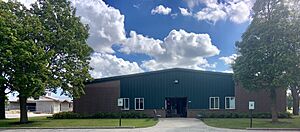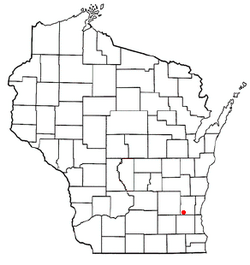Erin, Wisconsin facts for kids
Quick facts for kids
Erin, Wisconsin
|
|
|---|---|

Town hall in Thompson, Wisconsin
|
|
| Motto(s):
Erin Go Bragh
|
|

Location of Erin, Wisconsin
|
|
| Country | |
| State | |
| County | Washington |
| Area | |
| • Total | 36.3 sq mi (94.0 km2) |
| • Land | 35.9 sq mi (92.9 km2) |
| • Water | 0.4 sq mi (1.1 km2) |
| Elevation | 1,010 ft (308 m) |
| Population
(2009)
|
|
| • Total | 4,525 |
| • Density | 102.2/sq mi (39.4/km2) |
| Time zone | UTC-6 (Central (CST)) |
| • Summer (DST) | UTC-5 (CDT) |
| Area code(s) | 262 |
| FIPS code | 55-24225 |
| GNIS feature ID | 1583171 |
Erin is a town in Washington County, Wisconsin, in the United States. In 2000, about 3,664 people lived there. A small community called Thompson is also part of Erin.
Erin is famous for Erin Hills, a golf course. This course hosted a very important golf event, the 2017 U.S. Open golf tournament.
Contents
History of Erin
Early Days and Native Americans
Before the 1830s, the land where Erin is now was home to Native American tribes. These included the Menominee and Potawatomi people. They had lived there for a very long time.
Some old stories say that Jesuit missionaries were the first white people to visit the area. This might have happened as early as the 1670s. Some historians believe that explorers Jacques Marquette and Louis Jolliet might have stopped in Erin in 1673. They were looking for the Rock River. They might have even placed a wooden cross on Holy Hill. But it's hard to be sure because old records are not always very detailed.
Land Changes and New Settlers
In 1833, the Potawatomi tribe gave up their land claims to the United States government. This was part of the 1833 Treaty of Chicago. The treaty meant they had to leave Wisconsin by 1838. Many Potawatomi people moved west to Kansas. However, some chose to stay in Wisconsin. They were sometimes called "strolling Potawatomi." This was because they often moved around and lived on their old lands, which were now owned by new settlers. Native Americans continued to live in Washington County into the late 1800s. Many of them later joined together in northern Wisconsin. They formed the Forest County Potawatomi Community.
Founding the Town
The Wisconsin Territorial Legislature officially created the Town of Erin on January 16, 1846. It was likely named after Erin, a poetic name for Ireland. Many of the first settlers in the town came from Ireland. In fact, by 1940, almost 90% of the people in Erin said they had Irish family.
Farming and Local Life
Since it was founded, Erin has mostly been a farming community. Dairy farming has been a very important part of the local economy. In the early days, there were businesses like blacksmiths and general stores. There were also creameries that helped the local farmers.
Holy Hill and Community Growth
Erin has had a large Catholic community for a long time. In the 1860s, a Catholic priest built a small log chapel. It was a special place dedicated to Mary Help of Christians on top of Holy Hill. Many pilgrims (people who travel for religious reasons) came to visit.
The log chapel was replaced with a brick church in 1881. In 1906, a group of Carmelite friars from Bavaria came to Holy Hill. They built a monastery there in 1920. By 1925, the church was too small for all the visitors. So, two new churches were built between 1926 and 1931. Holy Hill is now one of the most visited Catholic pilgrimage sites in the Midwest. It became a minor basilica in 2006.
For its first 100 years, Erin's population stayed about the same. But after World War II, the town grew a lot. The population became four times bigger between 1950 and 2010. Some areas saw new neighborhoods being built. Even though some people didn't want the town to become more like a suburb, Erin is still mostly a rural, farming community today.
Geography
Erin covers about 36.3 square miles (94.0 square kilometers). Most of this area, about 35.9 square miles (92.9 square kilometers), is land. The rest, about 0.4 square miles (1.1 square kilometers), is water.
Population
In the year 2000, there were 3,664 people living in Erin. The average age of people in the town was 39 years old.
Religion
The Roman Catholic shrine of Holy Hill National Shrine of Mary, Help of Christians is located in the town of Erin. It is a very important religious site.
Notable people
- Daniel Cavanagh, a politician
- Joseph E. Russell, a politician
Images for kids
-
Erin Hills: a golf course
See also
 In Spanish: Erin (Wisconsin) para niños
In Spanish: Erin (Wisconsin) para niños




